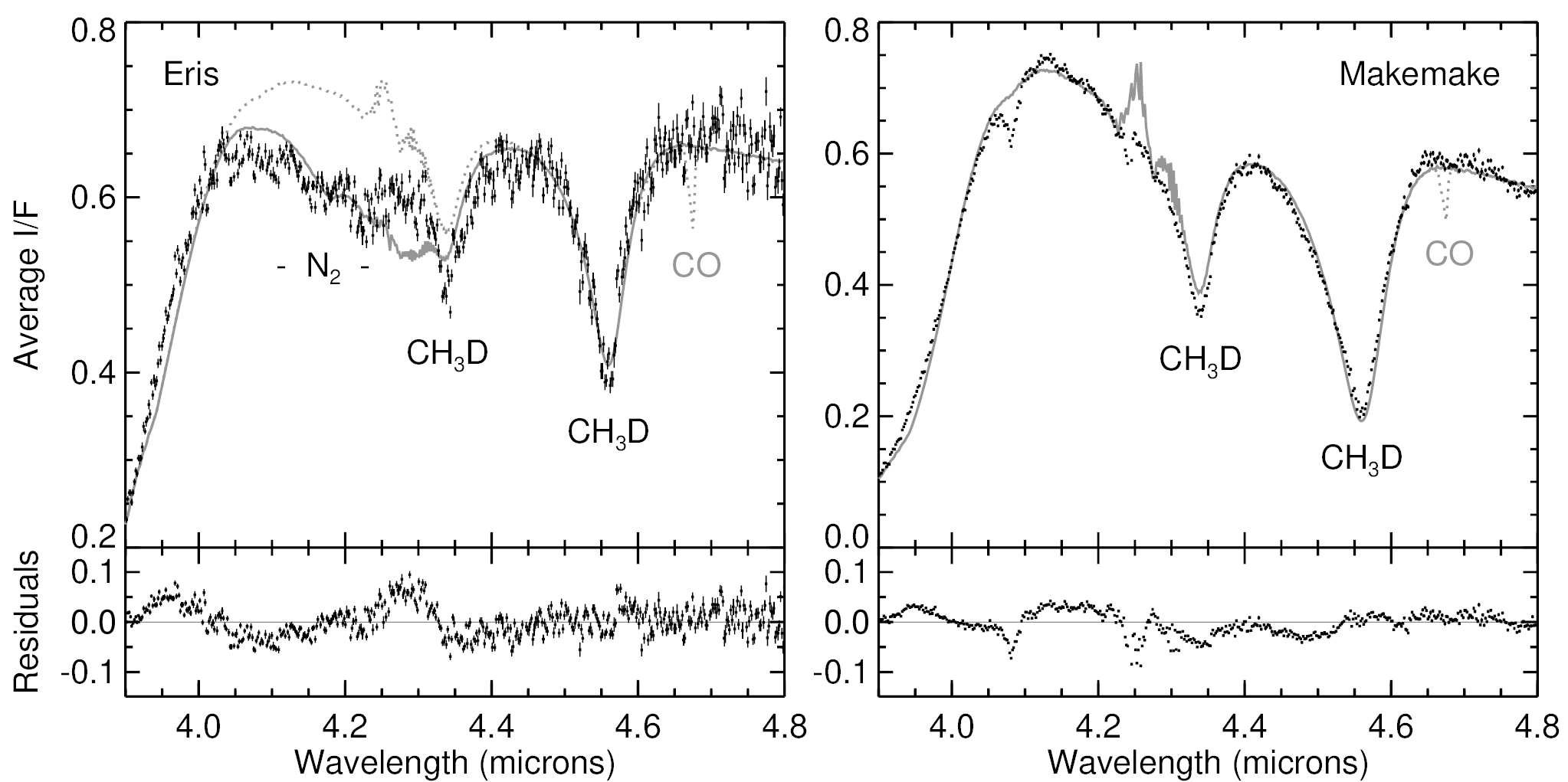
Measurement of D/H and 13C/12C Ratios in Methane Ice on Eris and Makemake: Evidence for Internal Activity
Published in 2024 in Icarus 411, 115923 DOI: 10.1016/j.icarus.2023.115923
W.M. Grundy1,2, I. Wong3,4, C.R. Glein5, S. Protopapa5, B.J. Holler6, J.C. Cook7, J.A. Stansberry6, J.I. Lunine8, A.H. Parker9, H.B. Hammel10, S.N. Milam3, R. Brunetto11, N. Pinilla-Alonso12, A.C. de Souza Feliciano12, J.P. Emery2, and J. Licandro13
(1) Lowell Observatory, Flagstaff AZ.
(2) Department of Astronomy and Planetary Science, Northern Arizona University, Flagstaff AZ.
(3) NASA Goddard Space Flight Center, Greenbelt MD.
(4) American University, Washington DC.
(5) Southwest Research Institute, San Antonio TX and Boulder CO.
(6) Space Telescope Science Institute, Baltimore MD.
(7) Pinhead Institute, Telluride CO.
(8) Cornell University, Ithaca NY.
(9) SETI Institute, Mountain View CA.
(10)Association of Universities for Research in Astronomy, Washington DC.
(11)Université Paris-Saclay, CNRS, Paris, France.
(12)Florida Space Institute, University of Central Florida, Orlando FL.
(13)Instituto de Astrofísica de Canarias (IAC) La Laguna, Spain.
Abstract
James Webb Space Telescope’s NIRSpec infrared imaging spectrometer observed the outer solar system dwarf planets Eris and Makemake in reflected sunlight at wavelengths spanning 1 through 5 microns. Both objects have high albedo surfaces that are rich in methane ice, with a texture that permits long optical path lengths through the ice for solar photons. There is evidence for N2 ice absorption around 4.2 μm on Eris, though not on Makemake. No CO ice absorption is seen at 4.67 μm on either body. For the first time, absorption bands of two heavy isotopologues of methane are observed at 2.615 μm (13CH4), 4.33 μm (12CH3D), and 4.57 μm (12CH3D). These bands enable us to measure D/H ratios of (2.5 ± 0.5) × 10−4 and (2.9 ± 0.6) × 10−4, along with 13C/12C ratios of 0.012 ± 0.002 and 0.010 ± 0.003 in the surface methane ices of Eris and Makemake, respectively. The measured D/H ratios are much lower than that of presumably primordial methane in comet 67P/Churyumov-Gerasimenko, but they are similar to D/H ratios in water in many comets and larger outer solar system objects. This similarity suggests that the hydrogen atoms in methane on Eris and Makemake originated from water, indicative of geochemical processes in past or even ongoing hot environments in their deep interiors. The 13C/12C ratios are consistent with commonly observed solar system values, suggesting no substantial enrichment in 13C as could happen if the methane currently on their surfaces was the residue of a much larger inventory that had mostly been lost to space. Possible explanations include geologically recent outgassing from the interiors as well as processes that cycle the surface methane inventory to keep the uppermost surfaces refreshed.

Fig. 3. Spectra and models for Eris (left panel) and Makemake (right panel) zoomed in on the region of the strong CH3D bands. Dotted curves showing narrow features at 4.67 μm have trace amounts of CO ice added in the model: 2 parts per million by volume for Eris and 1 ppm for Makemake, quantities that would have been detected if they had been present. The dotted curve in the Eris panel with higher reflectance values between 4.0 and 4.3 μm shows the effect of removing the N2 ice. Apparent features in the model spectra between 4.23 and 4.33 μm should be ignored. They are due to poor removal of gas phase CO2 absorption from the laboratory absorption data for CH4 ice. The band at 4.08 μm in the Makemake spectrum is a component that is absent from our models, possibly SO2 (e.g., Schmitt et al. 1994, 1998; Schriver-Mazzuoli et al. 2003).